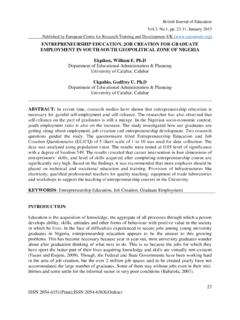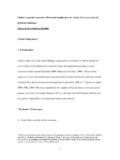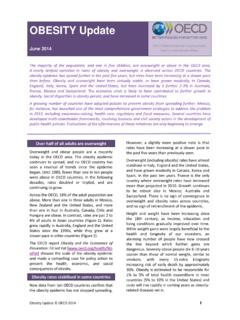Transcription of Third Point Q1 2018 Investor Letter Final
1 Third Point LLC 390 Park Avenue New York, NY 10022 Tel 212 715 3880 May 4, 2018 First quarter Investor Letter Review and Outlook A benign and extended period of low market volatility ended abruptly in the first quarter of 2018. The S&P s 12% peak to trough drawdown during the quarter was the sharpest since Q1 2016 and the index s overall quarterly losses of marked its weakest annual start since 2009. Third Point s performance was less volatile but the end result was similar with the Offshore Fund losing and the levered Ultra Fund losing through the end of March. Losses during the quarter were driven primarily by long equity investments in cyclical sectors while gains came from the short book and credit strategies. The funds were profitable in April, bringing performance to roughly flat for the year. A shift in markets occurred in Q1. After a two year period where growth surprised positively and inflation was benign, we began to see volatility in each of these areas.
2 While earnings growth remains strong, investors now have to contend with increased uncertainty around appropriate multiples. One cause of this uncertainty is that, after many years of very low rates, there is finally an alternative to equities in the form of relatively riskless two year money. We have seen the impact of this new option in money market flows where $400 billion has flooded in so far this year versus a total $80 billion of inflows in 2017. Also, as manufacturing indices (PMI s) cool from elevated levels, there is a real question about just which inning of the late cycle we are in. While we don t believe a recession is close, there is definitely a concern that it is getting closer. Each of these considerations is weighing on multiples. For investors, this means the S&P is effectively range bound and so, to generate profits, investors will need to adjust exposures more aggressively and successfully choose winners and losers across sectors.
3 We have responded to this regime shift in several ways. First, we have reduced net exposure by over 20% this year. We have taken about 15% exposure out of our long book and boosted 2 shorts to about 25% of fund AUM. Last year s focus on short selling after several years away from the strategy was a return to our early success as short sellers. We intend to further increase exposure to fundamental single names and quant derived baskets in 2018 and rely less on market hedges to dampen volatility and reduce net exposure. Beyond a balanced approach to equities, we are spending more time evaluating opportunities in risk arbitrage. While credit strategies performed well in Q1, we find most corporate credit markets are too richly valued relative to equities and so we have modest exposure to the asset class. As we discuss below in our structured credit update, we have been finding fewer opportunities in RMBS after selling most of our portfolio at a profit and are currently focusing on marketplace lending deals instead.
4 Quarterly Results Set forth below are our results through March 31, 2018: Third Point Offshore Ltd. Third Point Ultra Ltd. S&P 500 2018 YTD Performance* Annualized Return Since Inception** Comparable S&P Annualized Return** *Through March 31, 2018. **Return from inception, December 1996 for TP Offshore; from inception, May 1997 for TP Ultra. The top five winners for the quarter were Netflix Inc., Pagseguro Digital Ltd., Airbus SE, BlackRock Inc., and CGG SA. The top five losers for the period were Nestl SA, DowDuPont Inc., Facebook Inc., Fannie Mae/Freddie Mac, and Vulcan Materials Co. Assets under management at March 31, 2018 were $ billion. 3 New Position United Technologies Corporation In the fourth quarter of 2017, Third Point initiated a significant stake in United Technologies Corporation ( UTC or the Company ), a $100 billion industrial conglomerate organized into four business units: Otis Elevator Company ( Otis ), UTC Climate, Controls & Security ( CCS ), UTC Aerospace Systems ( UTAS ), and Pratt & Whitney.
5 UTC has strong franchise assets with leading market share within each segment but the Company s shares have lagged its industrial peers (XLI Index) by approximately 45% over the last five years. UTC fits a pattern of many underperforming conglomerates where value is diminished by the ill effects of a one size fits all approach to corporate strategy, incentive compensation, and capital allocation. At UTC, this has led to a well documented history of poor management execution exemplified most recently by the botched ramp up of the next generation geared turbofan ( GTF ) engine as well as market share losses and underinvestment in key business areas. We have initiated a dialogue with UTC s Board of Directors to express our concerns about the Company s weak operating performance and the inherent disadvantages of its conglomerate structure. To reverse its years of underperformance and realize the full potential of its franchise assets, we believe UTC should split into three focused, standalone businesses: Otis, CCS, and an aerospace company ( Aerospace RemainCo ) encompassing UTAS and Pratt & Whitney.
6 In assessing the potential success of any such split, we ask ourselves two key questions: 1) are the business units and their key stakeholders better off as standalone entities; and 2) does the split create sustainable long term value? The answer to each of these questions is clearly yes. We are encouraged that the Company s CEO, Greg Hayes, has indicated that the Board is undertaking a portfolio review. We expect that an honest process will lead the Board to the same inescapable conclusion that UTC should be split into three. The Case for a Split As standalones, each of these businesses will benefit in the long run from a bespoke corporate strategy, more flexibility in allocating capital, better alignment of management 4 incentives, a dedicated board of directors with relevant industry experience, and greater strategic optionality. The value creation from spin offs has been well documented in academic studies and has many relevant precedents in the industrial sector including Danaher/Fortive, Ingersoll Rand/Allegion, Northrop Grumman/Huntington Ingalls, ITT/Xylem/Exelis, and Tyco/Covidien/TE Connectivity.
7 Beyond these spin off benefits, we believe the split would also highlight to the market the overlooked value of the GTF program currently hidden within UTC. The profitability of the GTF program will inflect positively as the GTF moves down the manufacturing learning curve and the highly profitable service revenue stream ramps with the installed base. Management has assessed the net present value of the GTF program at approximately $15 billion1 or $19 per share. Giving credit to GTF s NPV rather than capitalizing today s ramp up losses of $ billion would lower UTC s headline valuation multiple of 11x forward EV/EBITDA to just 9x forward EV/EBITDA. The average forward EV/EBITDA multiple for the US large cap multi industry peer group is 13x or ~40% higher. We believe such a significant disconnect exists because in addition to issues with management execution UTC s current Investor base is misaligned.
8 Multi industrial investors (a sector defined by low earnings volatility) value companies primarily on multiples of next year s earnings and cash flow. Aerospace investors, on the other hand, tend to look through new program start up losses once they are comfortable that peak losses and subsequent profit improvement are in sight. One clear example of this is Rolls Royce. If Rolls Royce were a subsidiary of UTC, it certainly would not be valued currently at $23 billion or 36x forward P/E. Even before giving credit to GTF s NPV, a three way split would unlock in excess of $20 billion of value (>20% of market cap), net of separation costs. All three standalone entities 1 "The reality is just those 7,000 [GTF] engines we have on the order book today will generate more than $7 billion of positive value. Not negative.
9 And by the way, that s not the end of it. It s not going to be that we are done with 7,000 engines. That number is going to grow to 15,000 or more by the time we are done Akhil Johri, UTC Investor Day, 3/10/16 5 will likely trade at higher multiples than the lowest common denominator assigned to the current UTC conglomerate. Otis peers Kone and Schindler trade on average at 15x forward EV/EBITDA. CCS peers, Allegion, Ingersoll Rand, and Lennox2, trade on average at 13x forward EV/EBITDA. The remaining aerospace company would be the only liquid, US large cap aerospace supplier other than TransDigm, which trades at 15x forward EV/EBITDA. Other US large cap aerospace investment opportunities are limited to Boeing and Honeywell (only ~40% aerospace), which trade at 14x and 15x forward EV/EBITDA3, respectively. The Aerospace RemainCo will warrant a premium multiple due to synergy potential from Rockwell Collins and Pratt & Whitney s depressed earnings.
10 If Pratt & Whitney achieves an 18% EBIT margin by 2025, which management cited as a target, it will generate approximately $6 billion in EBITDA, which compares to $ billion this year. Assigning a 13x EV/EBITDA multiple to Aerospace RemainCo after stripping out the GTF losses yields a UTC sum of the parts valuation over $190 per share4 by year end 2019. We see further upside to $210 per share if investors give credit to GTF s positive NPV. UTC s management has acknowledged the disconnect between the Company s intrinsic value and share price but it seems less open to a three way split solution than shareholders might expect. Management s initial assessment of dissynergies and one time separation costs was surprisingly high, particularly considering that at the Investor Day in March 2018, Greg Hayes described each business unit as having all the infrastructure and all the SG&A they need to run on a day to day basis.






